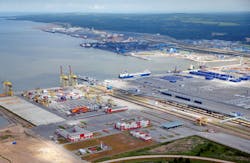Gazprom JV lets preliminary contract for Ust-Luga gas processing plant
PJSC Gazprom and RusGasDobycha have let a preliminary contract to a division of Linde PLC to deliver a suite of services for the natural gas processing portion of the planned gas processing, liquefaction, and chemical complex to be operated by RusKhimAlyans—a 50-50 special-purpose venture of Gazprom and RusGazDobycha—on the Gulf of Finland near the seaport of Ust-Luga, Leningrad Oblast, Russia (OGJ Online, June 10, 2020).
RusKhimAlyans and Linde Engineering on Mar. 26 signed an agreement of intent outlining main terms and conditions of a prospective contract under which Linde Engineering will provide engineering, procurement, and site services (EPSS)—including equipment supply and maintenance—on gas processing and off-site installations of the gas processing complex (GPC) at Ust-Luga’s complex for processing ethane-containing gas (CPECG), Gazprom said.
The operator disclosed no additional details regarding the new agreement, which follows the Gazprom-RusGasDobycha partnership’s recent termination of a contract with Sibur Group subsidiary Nipigaz for delivery of engineering, procurement, and construction (EPC) services on the GPC of the CPECG (OGJ Online, Mar. 17, 2021).
The RusKhimAlyans complex, which will have 13 million-tonnes/year liquefaction capacity, will receive 45 billion cu m/year (bcmy) of wet natural gas from Gazprom’s Achimov and Valanginian deposits in the Nadym-Pur-Taz region of the Yamal Peninsula. Gas remaining after processing (including ethane extraction) and LNG production, about 18 bcmy, will go into Russia’s gas transmission system. The complex will produce as much as 4 million tpy of ethane, and more than 2.2 million tpy of LPG.
LNG and LPG produced at the Ust-Luga complex will be exported, while ethane from the site will feed nearby RusGazDobycha subsidiary Baltic Chemical Complex LLC’s (BCC) proposed $13-billion ethane cracking project, which—once in operation—will produce more than 3 million tpy of polymers (OGJ Online, Nov. 9, 2020).
As of mid-February 2021, design documentation for the RusKhimAlyans gas processing, liquefaction, and off-site installations remained under state-expert view (OGJ Online, Feb. 18, 2021).
Amur GPP update
Gazprom also said on Mar. 26 construction activities remain on track at subsidiary OOO Gazprom Pererabotka Blagoveshchensk's 42 billion-cu m/year grassroots Amur natural gas processing plant (GPP) near Svobodny in Russia’s far-east Amur region (OGJ Online, Oct. 29, 2020).
The Amur GPP’s first two production trains for which Linde provided equipment for cryogenic gas separation—as well as for helium production elsewhere in the complex—currently are preparing for commissioning, according to the operator.
While it did not reveal a definitive timeframe for official commissioning, Gazprom last month confirmed the two production trains were on schedule for startup in 2021 (OGJ Online, Feb. 18, 2021).
Part of Gazprom’s implementation of its Eastern Gas Program (EGP) to integrate field developments, pipeline, and natural gas production centers in East Siberia and Russia’s Far East, the Amur GPP will process multicomponent gas it receives from EGP’s Irkutsk and Yakutia gas production centers via the Power of Siberia gas pipeline to support Gazprom’s commitment to supply 38 billion cu m/year of Russian natural gas into China over 30 years (OGJ Online, May 29, 2020; May 21, 2014).
Alongside producing about 2.5 million tonnes/year of ethane, 1 million tpy of propane, 500,000 tpy of butane, and 200,000 tpy of pentane-hexane fraction, the six-train Amur gas processing complex also will produce as much as 60 million-cu m/year of helium based on feedstock from Chayandinskoye field, which together with the company’s other reserves in East Siberia, forms one of the largest helium reservoirs in the world (OGJ Online, Dec. 19, 2012).

Robert Brelsford | Downstream Editor
Robert Brelsford joined Oil & Gas Journal in October 2013 as downstream technology editor after 8 years as a crude oil price and news reporter on spot crude transactions at the US Gulf Coast, West Coast, Canadian, and Latin American markets. He holds a BA (2000) in English from Rice University and an MS (2003) in education and social policy from Northwestern University.

